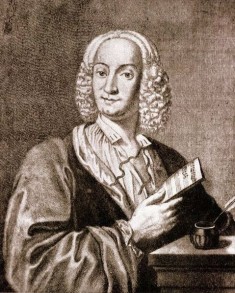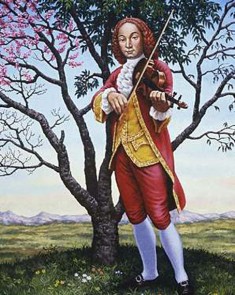| Antonio Vivaldi | |
|---|---|
 |
|
| Composer | |
| Born | Mar. 4, 1678 |
| Died | Jul. 28, 1741 |
| Nationality | Italian |
Antonio Vivaldi was a popular Italian Baroque composer, priest, and virtuoso violinist. He was nicknamed “The Red Priest” because of his red hair. His music and influence was widespread all over Europe. He is mainly known for composing instrumental concerts, sacred choral works, and more than 40 operas. Many also know him for his series of violin concerts entitled The Four Seasons.
Early Life
Antonio was born on July 28, 1678, in Venice, Italy. He was baptized immediately after he was born by a midwife. Many people thought the baptism at such an early age meant that he was either born in bad health or because there was an earthquake that day. His official church baptism, however, took place two months later. Antonio had five siblings.
Antonio experienced health problems when growing up. However, this did not stop him from learning how to play the violin, composing music, or even taking part in musical activities. In 1693, at the age of 15, he went to school to become a priest. At the age of 25, in 1703, he was ordained and nicknamed
il Prete Rosso (Red Priest).
Just after his ordination in 1704, Vivaldi was given a dispensation from celebrating Mass because he was sick. He only said Mass as a priest very few times before withdrawing from his priestly duties. However, he still remained a priest.
Vivaldi’s Career Highlights
In September of 1703, Antonio Vivaldi became master of the violin at an orphanage named the Pio Ospedala della Pieta (Devout Hospital of Mercy) in Venice. He was only 25 years when he started working in this orphanage and he spent the next 30 years working here.
During this time, there were four similar institutions in Venice which gave shelter and education to abandoned and orphaned children. The institutions were financed by the Republic and the boys learned a trade before they left when they turned 15. The girls were taught music and the talented ones joined a renowned orchestra and choir.
After Antonio was appointed to this institution, the children started to gain appreciation and esteem abroad. He wrote concertos, sacred vocal music, and cantatas for them to perform together. The sacred works, of which there are over 60, included large scale choral works, solo motets, orchestra and double chorus.
Antonio’s relationship with the board of directors of the orphanage was in most cases strained. The board took a vote each year to decide whether to keep a teacher or not. In 1709, the board decided not to keep Vivaldi. However, after one year of being away, the board recalled him. When he returned, the board made him responsible for all musical activities in the institution. In 1716, he was promoted to music director.
Major Works
 In 1705, Vivaldi’s very first collection of work, Connor Cassara, was published. In 1709, his second collection of 12 sonatas for the violin and bass continuo was published. His most successful operatic works are Farnace and La constanza trionfante.
In 1705, Vivaldi’s very first collection of work, Connor Cassara, was published. In 1709, his second collection of 12 sonatas for the violin and bass continuo was published. His most successful operatic works are Farnace and La constanza trionfante.
Apart from working at the institution, Antonio Vivaldi also accepted several short-term positions that were funded by patrons in Rome and Mantua. During his term in Mantua, between 1717 and 1721, he wrote a four-part masterpiece entitled The Four Seasons.
Vivaldi’s fans and patrons included the European royal families. One of his cantatas, entitled Gloria e Imeneo, was specifically written for the wedding of King Louis XV. Emperor Charles VI was also a great fan of Antonio and even named him a knight.
Later Years and Legacy
After his popularity declined, Antonio Vivaldi left Venice for Vienna in Austria. He went to look for a position in the imperial court located there. However, he was not successful. He died in poverty on July 28, 1741 and was buried in a very simple grave after a funeral service that proceeded without music.
Most of Vivaldi’s compositions were written for female music ensembles of the Ospedale della Pieta, which is a home for abandoned children where he was employed between the years 1703 and 1715 and again from 1723 to 1740. Although his music was well-received during his lifetime, it declined in popularity over the years. However, he still ranks among the most popular and widely recorded of Baroque composers.
Since WWI, his music has been widely performed. His work, which included about 500 concertos, has greatly influenced many composers, including Johann Sebastian Bach and other recognizable names.